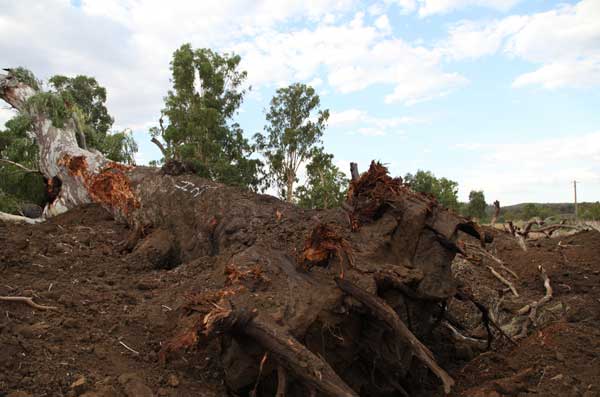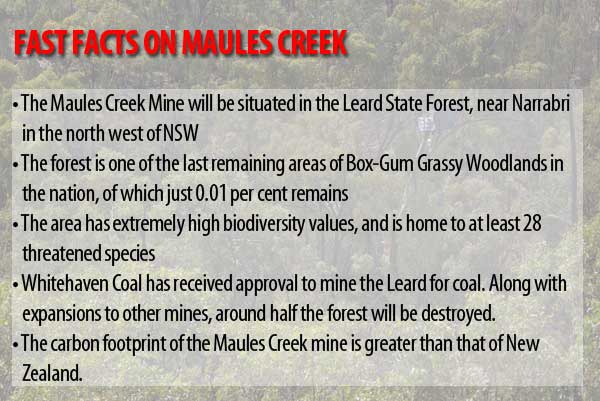Half of the nature-abundant Leard State Forest in NSW’s north west is slated to become a coal-pit, but environmentalists fear the total destruction of this unique biodiversity hotspot.
Today, New Matilda revealed that Whitehaven Coal’s controversial Maules Creek project has been operating without environmental oversight on its key community consultation panel for more than a year, exacerbating fears for the forest’s future.
The $767 million Maules Creek Mine, located near Narrabri, encroaches on the ecologically unique Leard State Forest, one of the last remaining stands of the critically endangered Box-Gum Grassy Woodland ecological community.
Just 0.01 per cent of Box-Gum Grassy Woodland remains nationally.
Around half of the forest will be destroyed by the Maules Creek Mine, together with expansions to Whitehaven’s nearby Tarrawonga mine and Idemitsu Resource’s Boggabri mine.
At least 28 threatened species are known to exist in the Leard State Forest.
“That’s a very high number, higher than that found in many of our National Parks,” local ecologist Phil Spark told New Matilda.
“The reason it’s so high is because many of the species are dependent on the Box–Gum Grassy Woodland.”
It’s that remarkable biodiversity which has spurred on one of the longest running – and most vigorously contested – environmental protests in the state’s history.

The land in and around Leard State Forest has been the site of a permanent protest camp for more than two years. Protestors originally dug in within the borders of the Leard, but were evicted from the State Forest in January.
But the protestors didn’t go far, relocating to ‘Camp Wando’, a private farm owned by Maules Creek farmer Cliff Wallace.
The unwavering community protest against the mine has resulted in almost 250 arrests, according to Phil Evans, a spokesperson for the Leard Forest Alliance, the group which has co-ordinated the ongoing resistance.
Opponents of the mine haven’t just limited themselves to blocking bulldozers and tree-sits. Activist Jonathan Moylan staged a now infamous hoax in 2013 after issuing a press release on fake ANZ letterhead, announcing the bank was withdrawing its financial support for the Whitehaven project.
The release, widely reported by mainstream media before it was discovered to be fake, briefly stripped more than $300 million off Whitehaven’s sharemaket value.
The money was recovered when news of the hoax spread, but Phil Spark notes that the environment never will if the Maules Creek project goes ahead.
“There is literally no other area of forest that can compensate for the loss of the extent and condition of woodland proposed to be cleared for this mine,” he wrote in a June report to Federal Minister for the Environment Greg Hunt.
Under the mine’s approval, Whitehaven is required to purchase property with Box-Gum Grassy Woodland habitat to ‘offset’ the destruction to the Leard State Forest.
By buying ‘like for like’ land, the company provides some compensation for its impact on the biodiversity hotspot.
However, offsets still result in a net-loss of the critically endangered Box-Gum Grassy Woodland, and there are very few instances of Box-Gum Grassy Woodland anywhere in the nation as good a condition as the Leard. Even worse, environmentalists are sceptical that it is even possible to find ‘like for like’ offsets where species that depend on the Box-Gum Woodland habitat can survive.
Whitehaven Coal’s struggle to buy up ‘like for like’ environments is testament to their rarity.
According to Dr John Hunter, a senior lecturer at Armidale University, the offsets declared by Whitehaven in the original Environmental Impact Assessment were 95 per cent wrong in the patch of forest he studied.
Dr Hunter was the lead signatory to a letter sent in May to Federal Environment Minister Greg Hunt. Thirty scientists expressed “grave concerns” over Whitehaven’s offsetting, and they called on the Federal Government to “send its most experienced ecologists to undertake a comprehensive biodiversity assessment of the offsets in question”.
“If it is found that the approval for the Maules Creek coal mine was based on offsets not found to be ‘like for like’ vegetation communities, nor equal to or better condition threatened species habitat, then we would urge you to revoke the approval of actions that will cause irreversible harm to threaten species and the critically endangered… woodland that is on the brink of extinction,” the letter reads.
Whitehaven and the Office of Environment and Heritage have both admitted the original offsets were flawed, and it is remains unclear whether the additional offsets since purchased by Whitehaven are adequate.
As you might expect, the mine’s whopping carbon footprint is also a major concern for environmentalists.
Dr Ian Lowe has studied the likely emissions of the mine’s estimated annual extraction of 13 million tonnes of coal, and he says the mine’s Co2 emissions “really are of global significance”.
“If the Maules Creek mine were a nation, it would rank 75th in the world for total emissions, ahead of the greenhouse gas emissions of 140 entire countries,” Dr Lowe has said.
That includes one of our closest neighbours, New Zealand.
“NSW would need to double its [most ambitious emissions reduction target]to undo the damage that would be done to the global atmosphere if this mine were allowed,” he said.

Motivated by the flawed offsets, the destruction of pristine and endangered flora and fauna, and the damage the mine will do to the global atmosphere, opponents to the mine have taken their protest beyond the forest.
Earlier this year, the Maules Creek Community Council – a group of local residents and farmers established to fight the mine – launched a legal challenge against the Biodiversity Management Plan (BMP) put up by Whitehaven, and approved by the Department of Planning & Environment (DoPE).
“Previous BMPs have completely missed threatened species including the Squirrel Glider, the Pale-Headed Snake and the Environmental Protection and Biodiversity Conservation Act-listed Tylophora linearis,” Nic Clyde, a Senior Climate Campaigner for Greenpeace Australia told New Matilda.
But the criticism isn’t restricted to the first version of the BMP. In May, Whitehaven received approval from DoPE for a revised BMP which allowed the mining giant to bulldoze the forest in the winter months, when a number of threatened species go into a type of hibernation known as ‘torpor’.
The Newcastle Herald reported at the time: “Whitehaven's plans include using machinery to shake inhabited trees to “encourage” creatures to leave before “gently” bulldozing and leaving them overnight to allow remaining animals to escape.”
Supporters of the Leard were outraged, and protest action reached fever pitch in the forest and the courts, with the Maules Creek Community Council pursuing legal action against Whitehaven in the Land & Environment Court.
With the Community Council poised to win an injunction in June, Whitehaven got cold feet and capitulated at the 11th hour, agreeing to abandon its winter plans.
“Clearing of vegetation should never have been allowed outside of the industry standard of 31 January to 1 May,” said Nic Clyde.
Winter has come and gone, but Whitehaven has since submitted a ‘revised revised BMP’, for DoPE’s consideration. Critics say the animals of the Leard Forest face a new threat under the latest iteration of the Maules Creek BMP.
“Whitehaven is (again) asking the Department for a one off ‘exception’ to allow the miner to commence clearing the Leard State Forest outside their normal clearing window without showing the environmental benefits of such an exception,” a spokesperson for the Maules Creek Community Council said this week after a further court hearing was postponed.
“The current biodiversity management plan is (also) inadequate. It is inconsistent as it aims to start clearing the Leard State Forest in November when young native animals are likely to be slaughtered in their nests.
“We’re now calling on the NSW Government to go a step further and provide a guarantee they will not approve a revised plan that will result in unnecessary animal deaths until the full legal challenge has been heard and a judgment handed down,” the spokesperson said.
The Maules Creek Community Council’s challenge to the revised BMP is set down for further mention in the Land & Environment Court on October 10.
Whitehaven expects to begin extracting coal by early next year, but opponents are determined never to let that happen.
For their part, DoPE has yet to approve the ‘revised revised BMP’. But for the lovers of the Leard, the BMP is just one of many problems.
One of the biggest is that that if Whitehaven ever does begin mining the forest, the 21-year life of the project will leave a massive hole in the ground.
It’s a hole Whitehaven, under its approval conditions, will never even have to fill, a reality not all that far removed from the hole exposed today in Whitehaven’s Community Consultation Committee.
Donate To New Matilda
New Matilda is a small, independent media outlet. We survive through reader contributions, and never losing a lawsuit. If you got something from this article, giving something back helps us to continue speaking truth to power. Every little bit counts.



